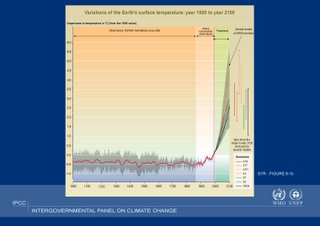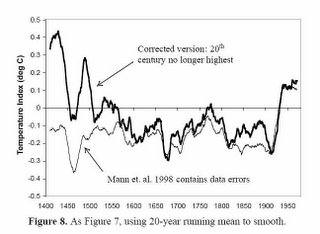1) The now famous Hockey Stick graph appears to show the earth’s climate as very stable from the years 1000-1900, and then veers upward sharply in the 20th century. Interestingly the projections for the next hundred years all have a clearly linear appearance (i.e., close to being straight lines going up at various angles). It has been ubiquitous and, according to McKitrick, the primary evidence in crafting the Kyoto recommendations.

2) Scientists try to figure out past climate various through various means including temperature proxies, or substitutes, as well as ground borehole data. Older studies had shown a medieval warm period, based on borehole evidence (i.e., literally drilling holes into the earth).

This warm period is problematic for adherents of global warming. The Mann data, upon which the hockey stick is based, used multiple proxies for temperature. This study indicated no such medieval warm period. Stephen McIntyre found a number of errors in the data, and he could not recreate the principle components (a statistical technique that seeks to simplify a vast data array into the most essential components). According to the author Mann refused to provide them with the computer code he used to create the statistical analyses published in Nature.
3) McKitrick suggests that Mann made errors in putting the statistics together. This resulted in a bias being created for a Hockey Stick-like trend in the 20th century. He suggests that the Mann study actually “data-mines” for hockey sticks.
4) Many of thee proxies used in the Hockey Stick study are very problematic, according to McKitrick. In fact experts that study some of these proxies (called bristlecone pine) have clearly indicated that they should not be used as climate proxies. It so happens that these proxies falsely show large temperature increases in the 20th Century (contradicting other data gathered in geographic proximity to the bristlecone pines). Drop that data and the Hockey Stick goes with it.
5) In the Hockey Stick study, there were insufficient proxies used to calculate many of the temperatures in the medieval period. Extrapolations were used (i.e., guesses, albeit sophisticated). Remove the poor data sources and redo the analysis and the medieval warm period reappears and greatly influences the look of the overall graph.
You can look at this comparison between the two studies. Now, there are arguments back and forth, and this can be very technical information. However, how many journalists have the expertise to report on this and do so fairly? Obviously this doesn’t settle the matter, but climatology is extremely complex, but so is statistical modeling, in any discipline. And with any statistics, GIGO is always relevant.

12 comments:
Climate Audit is Steve McIntyre's blog on these models.
Since the Sixties, science has become politicized as the Political Religion has taken hold pervasively in our instutions of higher learning. This has nearly destroyed the ability of public authorities to rely on scientists to make sensible policy decisions.
What do you make of the shrinking polar ice caps - on Mars?
Barry,
Thank you for taking the time to post on this.
I find myself rather amazed wrt the bristlecone dendrochronology findings. California (and New Zealand) redwoods would seem to provide a more reliable climate indicator given that the sempervirens is quite restricted in its range and not very adaptable. There are enough stumps along the western littoral to provide a decent data set and there are trees standing right next to the stumps which could give fairly definitive answers concerning what has happened in the past hundred years in comparison to the previous three hundred.
Ignoring the (or minimizing) the climate change that occured between 1000 and 1400 is simply ludicrous. The expansion and contraction of human settlement above the 40th parallel during and after that period isn't a conjecture.
Rick,
When I first read about the study, I had heard about the issue involving principle components and whether the statistical analyses were problematic. But the issues about the proxies are really interesting. Also, I believe there are some historical records from the range of 1000-1400 that mention climate (i.e., how hot or cold it is in such and such place, etc.). That is relevant, even if less reliable, because it acts as a way of checking whatever results come out of bristlecone pine analysis. McIntyre and McKitrick appear to have made numerous attempts to get the cooperation of Mann, but to no avail. I suggest we give the story to Helen Thomas :>).
I read Crichton's book State of Fear and I have to admit it made me wonder.
He included graphs that showed global warming in the past and he also included temperatures from specific countries and locations over a long period of time.
In fact he mentioned actual cooling in some places. For instance there was data showing that while the Antartic Peninsula has warmed the interior has cooled somewhat. Ice shelves have retreated but sea ice has increased.
People ignore the fact that sea level has been rising for thousands of years. In fact I remember that the tsunami in 2004 drove the sea back far enough to expose a forgotten city on the Indian coast that had been swallowed up by the sea long ago.
We tend to think of climate as if it were just weather. Our lifetimes are not long enough for us to have a memory of what normal is or even if there is such a thing.
brylun:
Hello there.
We know this planet we live on is cooling...
It is heated by radioactive decay in the interior. Before radioactive heating was discovered theorists had a problem: an old earth should have solidified, whereas other evidence pointed to an old earth.
RogerA,
I concur with Knuck - you may rant at will.
I'm still trying to untie the teeny tiny knot concerning the selection of the bristlecone pine series plus the "What Medieval Warm Period?"
Leif Ericson's peddling of the Greenland time shares in 1000AD plus his naming of a settlement at 52N "Vineland" hint at climate conditions somewhat different than those found today at the same locations.
What is needed is a survey of records from British monasteries. If they made notation of weather at, oh, say Christmas, it would sure be helpful. Or import customs duty registers from the Baltic trade. "First ship of season" would be a nice notation to find.
There's a particular topic on Climate Audit that I have to admit is beyond me, or at least beyond the amount of thought I'm willing to give it. It's at this.
It would appear to be the outline of a proof that one of the Mann et al methods of dealing with proxies means that the combination of proxies doesn't add information; this would be a pretty substantial flaw in their methods.
Seneca,
Looks basically right, at least the first paragraph looks right at first glance.
Later on, though, I have the sneaking suspicions the author is saying there are too many variables and too little data. How this situation could arise in PC I have no idea unless the regional data is all uncorrelated, which would make it kind of useless for predicting global effects. Damn, now I might have to go study the fookin' subject. Not what I wanted to do.
Knuck,
I certainly lack the math and statistics skills to offer a refutation of the hockey stick. But I don't have the requisite lack of the logical skills required to stare in open mouthed wonder at the making of conventional wisdom either.
Disclosure by Mann of his methodology may reveal that he developed an innovative and accurate means of properly assessing available data. Non-disclosure does not in any way "prove" that he is a charlatan and a hustler, it simply leaves the supposition open.
Mann controls the means by which to end the controversy on this point. If there is no statistical flummery involved I would imagine that putting McIntyre and McKitrick in their place might be a personally satisfying experience for Mann. Perhaps he is simply too busy to address the matter.
And perhaps he is a deceptive charlatan clinging to a vanishing reputation.
I certainly don't have the dispositive answer.
Post a Comment